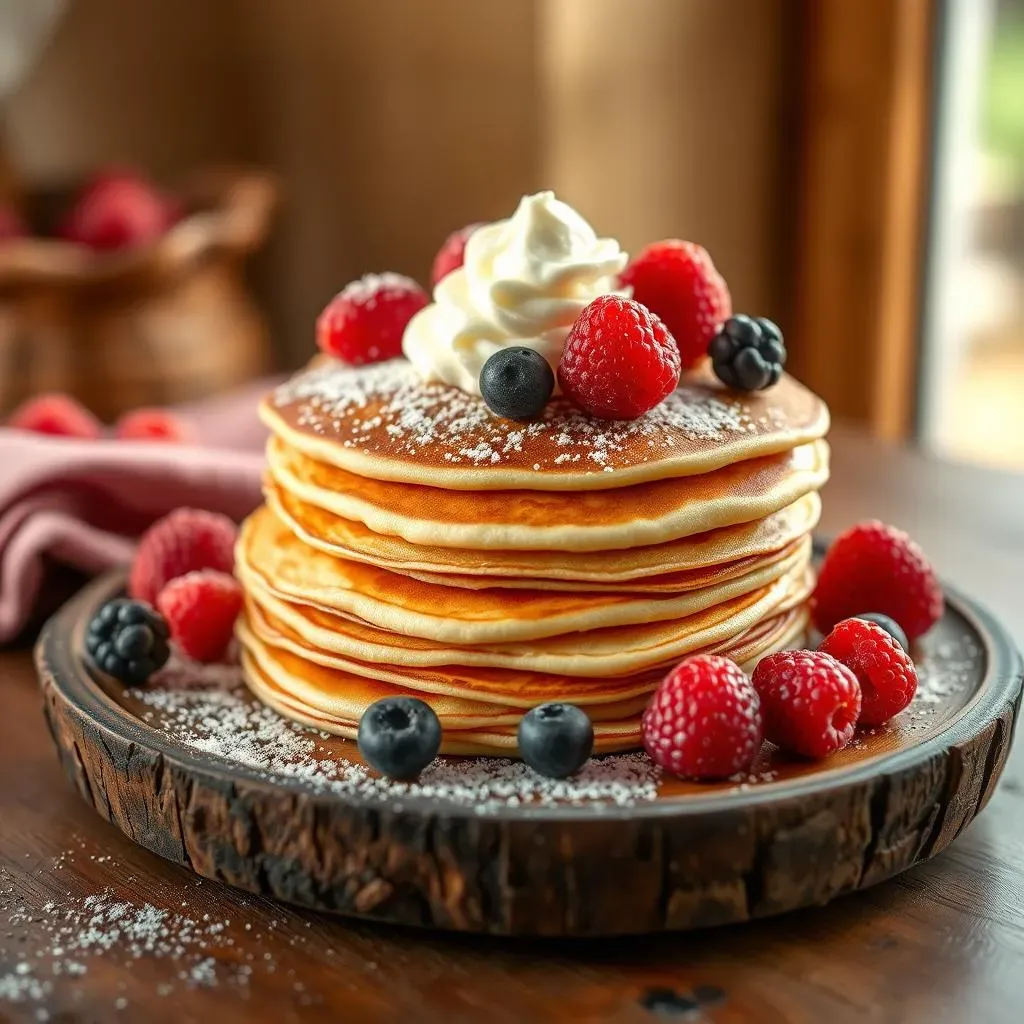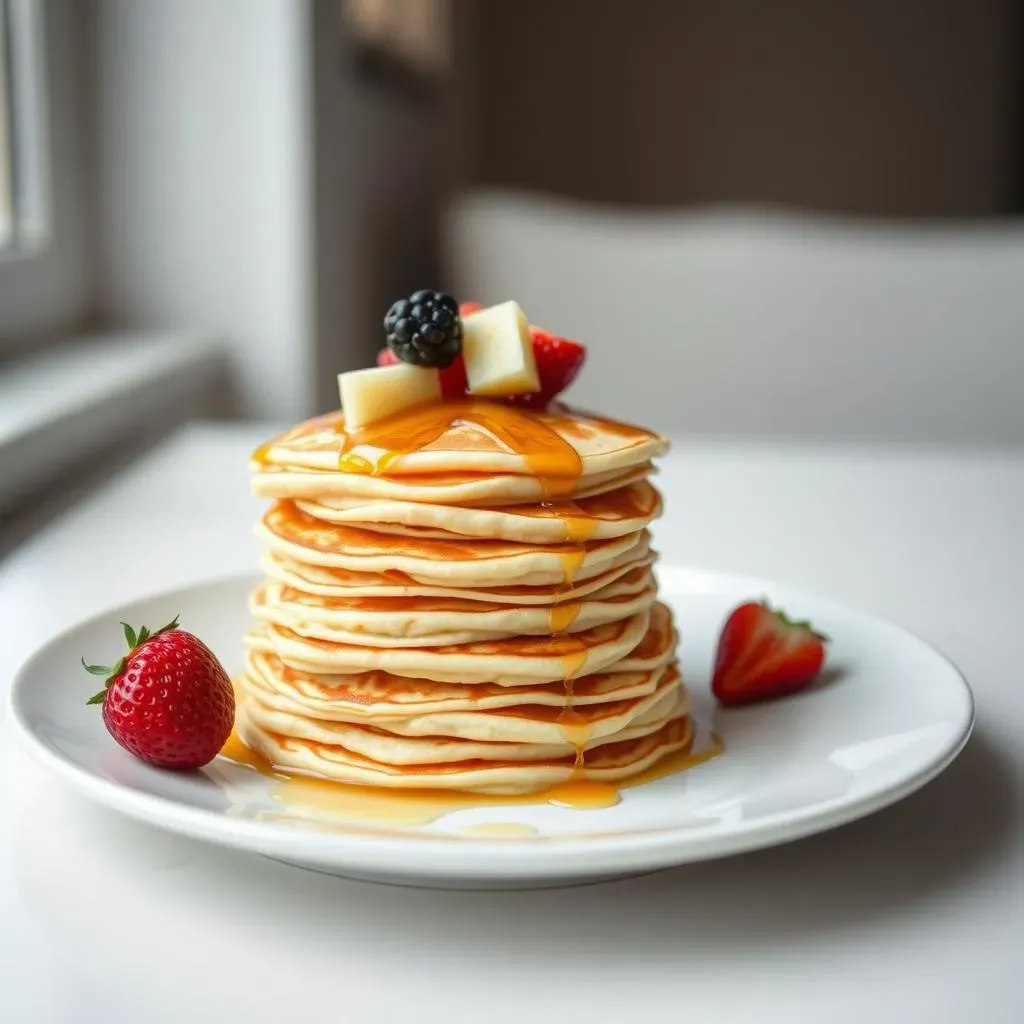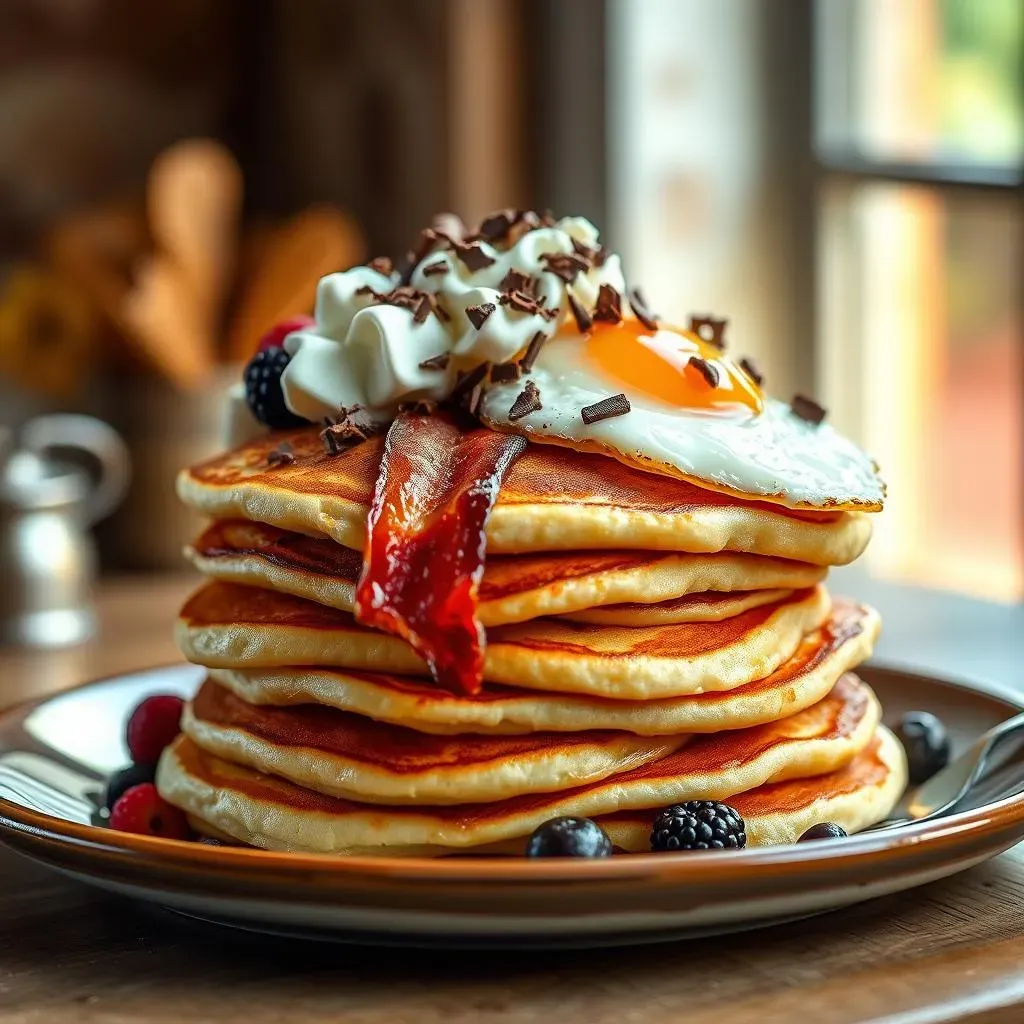Table of Contents
Ever dream of light, delicate pancakes that practically melt in your mouth? Forget those thick, fluffy discs; we're talking thin, lacy perfection. The secret? It's not just about your cooking skills, it's about starting with the right base, and that means choosing the best pancake mix for thin pancakes. This isn't your average pancake article; I'm gonna show you how to navigate the world of mixes, focusing on what makes a mix great for thin pancakes. We'll explore top contenders and I’ll give you the inside scoop on how to tweak them for that perfect thin texture. I'll also share some of my favorite variations, so you can whip up something truly special. Get ready to ditch the dense and embrace the delicate - by the end of this, you'll be a thin pancake pro!
Understanding What Makes a Pancake Mix Great for Thin Pancakes

Understanding What Makes a Pancake Mix Great for Thin Pancakes
The Flour Power
Alright, let's get real about flour. It's the backbone of any pancake, but not all flours are created equal, especially when we're chasing thin pancakes. You see, the protein content in flour matters a ton. High-protein flours, like some bread flours, can make your pancakes tough and chewy – definitely not what we want. For those delicate, thin crepes, we need a lower protein content. Think cake flour or pastry flour; they're the secret weapon. Most pancake mixes use all-purpose flour, which is fine, but knowing this is key if you want to adjust your mix later.
Another thing to consider is the fineness of the flour. Super finely milled flour will give you a smoother batter, translating to a more even and delicate pancake. It’s like the difference between using beach sand and fine powder in a sandcastle. The finer the flour, the less likely you'll have lumps in your batter, and the smoother the resulting pancake will be. Ever had a gritty pancake? Yeah, me neither, and we're not going to start now!
Leavening Agents: Less is More
Baking powder and baking soda are our leavening buddies, the agents that give your pancakes that rise we all know and love. But here's the thing: we don't want a lot of rise for thin pancakes. Too much leavening will make them thick and fluffy, and we're going for thin and lacy, remember? So, a mix that uses a smaller amount of leavening is a good place to start, or you'll need to adjust the amounts yourself when you're cooking, which is what I usually do. It's all about finding that delicate balance. A small amount of baking powder will give the pancakes just enough lift to create those beautiful, lacy edges, without making them puffy.
Also, consider if the mix already has added sugar. Too much sugar can make your pancakes brown too quickly, which is not ideal when you want a light and evenly cooked thin pancake. A bit of sugar is fine, as it helps with browning and flavor, but if you're going to be adding sweet toppings, you might want to start with a mix that has less sugar. It’s all about having control, and understanding the role of each ingredient in the mix is the first step.
Factor | Impact on Thin Pancakes |
|---|---|
Flour Protein Content | Lower protein (cake/pastry flour) yields thinner, less chewy pancakes. |
Flour Fineness | Finer flour creates smoother batter and more even pancakes. |
Leavening Agents (Baking Powder/Soda) | Less leavening results in thinner pancakes; too much makes them thick. |
Sugar Content | Moderate sugar is best; too much can lead to rapid browning. |
Top Pancake Mixes for Achieving Thin, Lacy Pancakes

Top Pancake Mixes for Achieving Thin, Lacy Pancakes
The Contenders: Mixes That Get it Right
Okay, so now we know what to look for in a mix, let's talk specifics. Finding the best pancake mix for thin pancakes can feel like searching for a unicorn, but trust me, they're out there. You're not going to find one that says "thin pancake" on the box, but you can find mixes that are close to perfect. We're looking for those with lower protein content and less leavening, and some brands do a better job than others. I've found that some "buttermilk" pancake mixes tend to be a good starting point, as they often have a finer texture and a slightly lower rise when compared to regular pancake mixes. I've tested countless brands, and I'm gonna share the ones that consistently deliver those thin, lacy edges we're after.
Another thing I look for is simplicity. If a mix has a bunch of unnecessary additives or artificial flavors, it's usually a no-go for me. I prefer mixes with a short, simple ingredient list because it gives me more control over the final product. Sometimes less is more, especially when you're aiming for delicate, thin pancakes. Remember, we're not looking for a mix that does all the work for us; we're looking for a solid base that we can tweak to create thin pancake magic. The best mixes are like a blank canvas, ready for us to make them our own.
My Top Picks and Why
So, after all that testing and tweaking, here's what I've found. First up, I'd recommend looking at brands that offer a "crepe mix". They might not be labelled as a pancake mix, but the ingredient are similar, and the result is what you are looking for. If you cannot find this, go for a buttermilk mix as your second option. These mixes often have a lower protein content and a finer texture, which gets us closer to that thin pancake ideal. They also tend to have less leavening, which is exactly what we want. However, even with these mixes, there are still some adjustments we can do to make them even better.
Now, don't get me wrong, these mixes aren't perfect straight out of the box. We still need to tweak and adjust to get that perfect thin, lacy pancake. But they provide an excellent foundation, a good starting point. The key is to experiment and find the mix that works best for you, and your taste. Once you find that mix, you can start to play with the liquid ratio, the cooking temperature, and the cooking time to achieve the ideal thin pancake. Remember, it's all about the journey, and the delicious pancakes you make along the way.
Mix Type | Why it's Good for Thin Pancakes | Things to Watch Out For |
|---|---|---|
Buttermilk Mixes | Often have a finer texture and less leavening. | Can sometimes be a bit too sweet. |
Crepe Mixes | Designed for thin pancakes, naturally. | May require specific cooking techniques. |
Simple, Low-Sugar Mixes | Provide a good base for customization. | Might need more tweaking to achieve desired thinness. |
Tips for Using Pancake Mix to Create Thin Pancakes

Tips for Using Pancake Mix to Create Thin Pancakes
The Batter's the Thing
Okay, so you've got your mix, now it's time to talk about the batter. The key to thin pancakes isn't just about the mix itself, it's about how you prepare it. The first thing you need to do is adjust the liquid ratio. Most pancake mix instructions will tell you to add a certain amount of water or milk, but for thin pancakes, you need to add more liquid than they recommend. Think of it like this: you're aiming for a batter that's more like a thin cream than a thick paste. It should pour easily from your spoon, almost like a thick milkshake. Don't be afraid to experiment. Start by adding a little extra liquid at a time, and mix it well, until you achieve the desired consistency.
Another tip is to let the batter rest for a bit. This allows the flour to fully absorb the liquid, which will make your pancakes lighter and more tender. I usually let my batter rest for about 10-15 minutes while I'm getting the pan ready. It's a small step, but it makes a big difference in the final result. And here's a pro tip: if you accidentally add too much liquid and your batter is too thin, you can add a tablespoon or two of dry mix to thicken it back up. It's all about learning to adjust to find what works best for you.
Cooking it Right
Now, let's talk cooking. The temperature of your pan is crucial when it comes to thin pancakes. If the pan is too hot, the pancakes will cook too quickly and burn before they get thin and lacy. If the pan is too cold, they'll just soak up the grease and become soggy. You want to aim for a medium-low heat. This gives the pancakes enough time to spread out thinly and cook evenly. I like to use a non-stick pan and add a very small amount of butter or oil to the pan. Just enough to keep the pancakes from sticking. You don't want them to fry, just gently cook.
When you pour the batter onto the pan, pour a small amount, and quickly swirl the pan so the batter spreads out into a thin circle. If you're having trouble getting it thin enough, you can use the back of a spoon to spread the batter even more. The thinner the batter, the faster it cooks, so you want to keep a close eye on them. Flip them when the edges start to look set and the bottom is golden brown. Don't be afraid to experiment to find the right timing. This is where practice comes in, and each pancake will get better and better.
Tip | Why it works |
|---|---|
Increase Liquid Ratio | Creates a thinner batter for thinner pancakes. |
Rest the Batter | Allows flour to absorb liquid for a lighter texture. |
Medium-Low Heat | Ensures even cooking without burning. |
Swirl the Pan | Helps spread the batter thinly and evenly. |
Technique Tweaks
Don't be shy about using a spatula to help you with the flip; it's a real game-changer. I prefer a thin, flexible spatula that can slide easily under the pancake. The key is to be quick and confident with your flip. If you hesitate, the pancake might fold or tear. If the first few pancakes aren't perfect, don't worry. It takes practice to get the hang of it, but trust me, it's worth it. The more you make pancakes, the better you'll become at flipping them, and you'll get a feel for the right consistency and cooking time.
Another thing I've learned is that the type of pan you use can also make a difference. A good non-stick pan is essential, but a well-seasoned cast iron pan can also work wonders. Just make sure it's heated evenly and not too hot. And finally, don't overcrowd the pan. Cook one or two pancakes at a time, depending on the size of your pan, to ensure they have enough space to spread out and cook properly. This will help you achieve those beautiful, thin, lacy pancakes that are so satisfying to make.
Best Pancake Mix for Thin Pancakes: Recipe Variations

Best Pancake Mix for Thin Pancakes: Recipe Variations
Sweet Sensations
Alright, so you've mastered the art of thin pancakes – congrats! Now, let's talk about making them even more exciting. One of my favorite things about thin pancakes is that they're a blank canvas for all sorts of deliciousness. When it comes to sweet variations, the sky's the limit. You can start by adding a splash of vanilla extract or a touch of almond extract to the batter for an extra layer of flavor. I also like to incorporate a bit of citrus zest, like lemon or orange, for a bright, zesty twist. And if you’re feeling extra fancy, a sprinkle of cinnamon or nutmeg can add some warmth and spice.
But don't stop there! Once your pancakes are cooked, you can get creative with toppings. Fresh berries, like strawberries, raspberries, and blueberries, are always a classic choice. Drizzle them with a bit of maple syrup or honey, and you have a simple yet elegant dessert. Or try a dollop of whipped cream and a sprinkle of chocolate shavings for a more indulgent treat. And if you're feeling adventurous, you can even add a scoop of ice cream and some caramel sauce. The options are endless, so don't be afraid to experiment and find your perfect sweet pancake creation.
Savory Surprises
Who says pancakes have to be sweet? I love exploring savory options. It's a fun way to switch things up and make pancakes a meal, not just a dessert. For a savory pancake variation, I start by adding some herbs and spices to the batter. A pinch of dried thyme, oregano, or rosemary can add a lovely earthy flavor. You can also incorporate some grated cheese, like Parmesan or Gruyere, for a cheesy kick. And if you're feeling adventurous, you can even add some finely chopped vegetables, like spinach or mushrooms.
As for toppings, think beyond the syrup and whipped cream. A fried egg on top of a savory pancake is a game changer – trust me on this one. Add a side of crispy bacon or ham for a complete meal. You can also top your savory pancakes with a dollop of sour cream or Greek yogurt and some fresh herbs. And if you're feeling really adventurous, you can even add some smoked salmon or avocado. The key is to think outside the box and experiment with flavors you love. Savory pancakes are a delicious way to enjoy this classic treat in a whole new way.
Variation | Batter Add-ins | Topping Ideas |
|---|---|---|
Sweet | Vanilla extract, citrus zest, cinnamon | Fresh berries, maple syrup, whipped cream, chocolate shavings |
Savory | Dried herbs, grated cheese, chopped vegetables | Fried egg, bacon, sour cream, smoked salmon |
Global Twists
Let’s take our thin pancake journey global. Think about how different cultures make and enjoy thin pancakes, and get inspired! For instance, you could try making a version of French crêpes by adding a bit of melted butter to the batter and using a very hot pan for a lacy texture. Then, fill them with Nutella or a homemade fruit compote. Or, you can try a take on Indian dosas by adding some spices like cumin and turmeric to the batter and serving them with chutneys or a savory filling like potatoes and peas.
Another idea is to create a version of Japanese crepes by adding some matcha powder to the batter for a unique green hue and a slightly bitter flavor. Serve them with red bean paste or whipped cream and fresh fruit. The possibilities are endless, and it's a fun way to explore different cuisines and flavors without leaving your kitchen. So, don't be afraid to experiment and let your taste buds guide you. The world is your oyster, or should I say, your pancake!